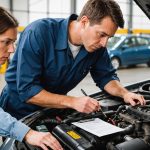In today’s world, safety on the road has become a top priority for many drivers. The integration of technology in vehicles has revolutionized the way we perceive and ensure safety while driving. As we navigate through busy streets, understanding how to utilize these modern technologies can significantly enhance the safety features of your vehicle. This article will guide you through various innovative systems and features that not only promote safe driving but also provide peace of mind to both drivers and passengers. Read on to discover how you can leverage these advancements to protect yourself and others on the road.
Understanding Modern Safety Technologies
To fully appreciate how technology can enhance your vehicle’s safety, it’s essential to understand the systems that are currently available. Modern vehicles are often equipped with a variety of advanced safety technologies designed to aid the driver during various driving scenarios. These include features like collision avoidance systems, adaptive cruise control, lane departure warnings, and automated braking systems.
Also read : What steps should I take to secure my vehicle against theft and vandalism?
Collision avoidance systems use radar and cameras to detect potential obstacles in your path. When a possible collision is detected, the system can alert the driver with visual and auditory warnings. If the driver does not respond in time, the system may engage the brakes automatically to prevent or mitigate an accident. This technology is particularly beneficial in high-traffic conditions where the risk of collisions greatly increases.
Adaptive cruise control is another significant advancement. This system adjusts your car’s speed to maintain a safe distance from the vehicle ahead. By automatically controlling the throttle and brakes, it allows drivers to enjoy a more relaxed driving experience while ensuring they remain safe on the road.
Also to see : What are the signs that my vehicle might need a safety recall check?
Lane departure warning systems are designed to help keep your vehicle within its designated lane. These systems use cameras to monitor lane markings and provide alerts if the vehicle begins to drift without signaling. Some systems can even gently steer the vehicle back into the lane, enhancing overall driving safety.
By understanding how these modern safety technologies work, drivers can become more adept at utilizing them to their advantage. Knowing what features are available in your car empowers you to make informed decisions that prioritize safety.
Integrating Safety Features into Your Daily Driving Routine
Once you are aware of the various safety technologies available, the next step is to integrate these systems into your daily driving routine. Familiarizing yourself with your vehicle’s safety features can transform your approach to the road.
Start by taking the time to thoroughly read your vehicle’s manual. Understanding the capabilities and limitations of your safety features is crucial. For instance, while adaptive cruise control can maintain a safe distance, it is not a substitute for attentive driving. Drivers should remain engaged and ready to take control of the vehicle at any moment.
When driving, consider using lane-keeping assist if your vehicle is equipped with this feature. It can help reduce the chances of drifting into adjacent lanes, especially during long trips or in heavy traffic. Additionally, make it a habit to check your vehicle’s blind spots, even if your car comes with lane change assists that monitor these areas. Always remember that these technologies are designed to assist you, not replace your responsibility as a driver.
Moreover, utilizing warning systems effectively is key to enhancing safety. Many vehicles are equipped with rear cross-traffic alerts, which can be a lifesaver when backing out of parking spaces. Be sure to pay attention to these alerts, as they serve as an added layer of protection against potential collisions.
Incorporating these technologies into your daily routine not only helps keep you and your passengers safe but also cultivates a habit of mindful driving. When you actively engage with these features, you will likely find that your overall driving experience becomes more enjoyable and less stressful.
The Importance of Regular Maintenance and Updates
While modern vehicles are equipped with various safety technologies, it is essential to remember that regular maintenance is key to ensuring these systems function effectively. Just like any other part of your car, safety features require care and attention.
Start with routine vehicle checks to ensure all safety systems are operational. This includes checking the sensors, cameras, and radar used by collision avoidance systems. If these components become dirty or misaligned, their effectiveness can be significantly compromised. Regular car washes can help maintain the cleanliness of these sensors, particularly during winter when road salt and grime can obstruct their functionality.
Additionally, many vehicle technologies receive updates, much like software on your smartphone. These updates can enhance features, improve performance, and fix bugs within the system. Ensure that you are aware of how to check for updates specific to your vehicle. Some manufacturers offer over-the-air updates, while others may require a visit to the dealership.
It’s also beneficial to keep an eye on your vehicle’s warning lights. If a safety light appears on your dashboard, do not ignore it. These warnings can provide crucial information about the status of your vehicle’s safety systems. Addressing these alerts promptly can prevent potential issues from escalating, ensuring your car remains in optimal condition.
By prioritizing regular maintenance and software updates, you can trust that your vehicle’s safety features will function as intended. This proactive approach solidifies your commitment to safe driving and helps reduce the risk of accidents on the road.
Future Trends in Vehicle Safety Technology
The landscape of vehicle safety is constantly evolving. As technology advances, we can anticipate new innovations that will further enhance safety for drivers and passengers alike. Understanding these trends can help you prepare for the future of driving.
One significant trend is the ongoing development of autonomous vehicles. While fully autonomous cars are still in the testing phase, advancements in this area promise to reduce human error, which is a leading cause of accidents. These vehicles will utilize sophisticated sensors, cameras, and machine learning algorithms to navigate roads safely, making decisions in real-time that prioritize the safety of all road users.
Another emerging trend is the integration of smarter connected vehicle technologies. Future vehicles will communicate with each other and with infrastructure, such as traffic lights and road signs. This communication will provide real-time data on traffic conditions, road hazards, and even upcoming accidents, enabling drivers to make informed decisions before they even encounter potential dangers.
Furthermore, the enhancement of existing safety technologies continues to be a focus for manufacturers. Features such as better collision detection systems, enhanced lane-keeping assists, and more responsive emergency braking systems are all on the horizon. As these technologies improve, the control drivers have over their vehicles will also enhance, leading to a safer road environment.
By staying informed about future trends, drivers can prepare for the next generation of safety features. Embracing these changes will not only enhance individual safety but also contribute to broader efforts aimed at reducing accidents on our roads.
In conclusion, leveraging technology to enhance your vehicle’s safety features is both practical and necessary in today’s driving landscape. By familiarizing yourself with modern safety technologies, integrating them into your daily routine, prioritizing regular maintenance, and staying abreast of future trends, you can significantly improve your safety on the road. As drivers, you hold the responsibility to actively engage with these technologies to protect yourselves and others. Embrace the advancements in vehicle safety and contribute to a safer driving experience for everyone.











